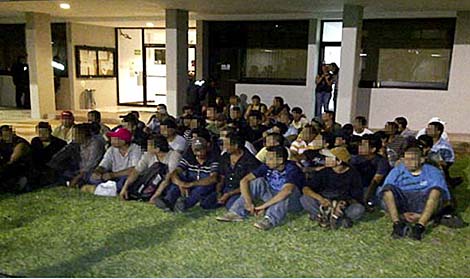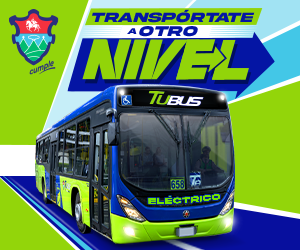Every night, César cleans the manure off his only pair of sneakers. He works at a stable taking care of cows and calves, but he doesn’t get a salary. The owner of the animals pays him with milk, which César sells going house to house. What he earns from the sales, about $5 a day, barely gives him enough to eat.
César, who is being identified only by his first name for fear of retaliation from the cartels, regrets that fate decided his birth in Progreso, Honduras, a village with streets without pavement, drainage or even names.
“I was born poor. We didn’t even have enough to eat. And 50 years later, I am still poor,” he said. “And so, I will surely die, without having something of my own.”
His village is a cradle for both gang members and migrants who go north toward the U.S. for a better way of life. César tried it two years ago, when he wanted to reunite with a brother who has lived in Jacksonville, Florida, for two decades. It almost cost him his life.
‘The Zetas were going to kill me’
In the early morning of Sept. 20, 2019, César took a backpack and a change of clothes. He said goodbye to his wife and left to meet the coyote, or smuggler, who would cross him through Mexico to reach the U.S.
César gave him his car as the first payment to pay off the first $2,300 he owed. If he managed to cross, he would pay the rest of the money, $5,500. Coyotes in the area charge $6,000 to $8,000, César said.
In Chiapas, Mexico, they took the train known as La Bestia heading north. In Puebla, officials from the National Migration Institute detained some of their colleagues. From that moment on, he traveled alone.
He crossed the state of Nuevo León and reached Reynosa, Tamaulipas, where he was kidnapped.
“At the bus terminal, there were some young people who told us that on one side those who had a guide should stand and those who didn’t on the other,” he said. “Those of us who were alone, they put us in a tourist van and took us to a safe house there in Reynosa.”
César and 20 other migrants were kidnapped and held for three weeks in a house that belonged to Los Zetas, the cartel to which his kidnappers belonged — as the migrants were told from the moment they were detained.
César already knew the reputation of Los Zetas: “I thought day after day, moment after moment since I arrived, that the Zetas were going to kill me, because they have no heart or soul,” he said.
The constantly threatening tone the criminals used confirmed his fears.
“If your brother wants to see you alive — to refresh his memory — give him a reminder,” César said they told him. “And they pushed me aside and gave me a beating.”
The cartels controlling the territories
Noticias Telemundo Investiga has interviewed more than 30 migrants who report having been kidnapped in different Mexican states by different criminal groups from 2019 to 2021. With these accounts, as well as information provided by sources from the Mexican attorney general’s office and the analysis of two experts on drug cartels, Noticias Telemundo Investiga has drawn up a map of migrant kidnappings in Mexico.
- In Tamaulipas, Los Zetas operate under the name Cartel del Noreste (Northeast Cartel) and Tropa del Infierno (Troop from Hell). The Gulf Cartel is also present through local gangs, such as Los Metros and Los Golfos.
- In Chiapas, in the south of the country, those who kidnap and extort migrants and their families belong to the Sinaloa Cartel, the Northeast Cartel and the Jalisco Nueva Generación Cartel, as well as Mara Salvatrucha cells in the area, near Guatemala.
- In Tabasco, a territory that migrants have to traverse because of its proximity to Chiapas, a state that borders Guatemala, the Jalisco Nueva Generación Cartel operates a cell commanded by a criminal nicknamed El Jardinero (The Gardener), according to several migrants’ accounts.
- On the northern border in Tijuana, in the state of Baja California, and in Ciudad Juárez, in the state of Chihuahua, the Jalisco Nueva Generación Cartel and the Sinaloa Cartel dominate. The latter also controls the border between Sonora and Arizona.
Interrogating the children
On the third day, César’s kidnappers took him and nine other people out of the Reynosa home across the river to McAllen, Texas. Crossing was very easy, he said.
“They put us on some very nice boats. They seemed luxurious, and there they crossed us,” he said. “Absolutely no one stopped us or told us anything. It seemed that everything was very well organized. With us were five more heavily armed men who were taking care of us.”
In McAllen, they were transferred to a nearby ranch, where 50 other people were already being held. The armed men warned them of the danger if they ran — and if their relatives did not pay the $5,000 ransom.
The criminals, who César said had Mexican accents, locked up the children to interrogate and threaten them. They wanted to know which family members were waiting for them in the U.S. It was a way to confirm that their parents were not lying to them.
“Crying women yelled at armed men, asking why were they taking their children. ‘If you want to know something, ask me,’ they would yell,” César said. “Then the child would come out crying. In his innocence and fear, he told the criminals everything they wanted to know.”
If the kidnappers discovered that information was false, the migrants were brutally beaten and the women were raped. Everyone was threatened with having fingers cut off if they did not tell the truth.
One night, when the ranch lights were turned off so the migrants could sleep, César escaped through a bathroom window. No one dared to accompany him. Outside, several armed men were guarding the house.
For cartels, ‘the perfect business’
In the last decade, drug cartels operating in Mexico have diversified their illicit businesses. One of the most profitable is irregular migration — the crossing of borders without the necessary documentation.
For researcher Guadalupe Correa-Cabrera, a specialist in drug trafficking and migration at George Mason University in Fairfax, Virginia, such activities pose few risks for criminal groups because migrants rarely report attacks.
“They don’t report them because they threaten them if they do so, and they don’t know who to turn to,” Correa-Cabrera said. “Most kidnappers have ties to the authorities, so it’s virtually impossible that they’ll take action against them. It is the perfect business.”
Mexico’s National Human Rights Commission uncovered the massive phenomenon of the kidnapping of Central American migrants in the country in 2008, when it recorded 198 kidnappings and 9,857 victims from September 2008 to February 2009.
The commission warned that drug cartels operating in the north of the country found the kidnapping and extortion of migrants to be lucrative.
Nilda García, a researcher at Texas A&M International University in Laredo, said criminal groups have taken good advantage of the circumstances. The flow of migrants at the border has tripled in the last 20 years, according to U.N. estimates.
“It is very difficult for these groups to pass up this profit, this opportunity to earn money with migrants. Kidnappings are one more layer of its structure,” she said.
In states like Puebla, local gangs have also emerged that have seen opportunities, and they operate freely, García said. They go unnoticed because when it comes to fighting kidnappings, the authorities have only the cartels in their sights.
“They are very well organized. Sometimes they have military training and access to high-caliber weapons to terrorize migrants,” she said.
Correa said local kidnappers operate with great efficiency because of their “social intelligence” — the almost perfect knowledge they have of their communities, their areas, the people and the routes, which gives them power and immunity in the territories they control.
What is Mexico doing?
There are no official figures, but Mexican authorities have reported several massive migrant kidnappings in the last month.
On Sept. 5, Foreign Minister Marcelo Ebrard reported the rescue in Camargo, Tamaulipas, of 162 migrants from Guatemala, Honduras and El Salvador who had been kidnapped and abandoned for five days in a warehouse without food.
On Aug. 31 in Cadereyta, Nuevo Léon, 327 migrants were rescued from a safe house where they were being held hostage. On Aug. 26, 208 people held captive in a warehouse in Puebla were released.
The total is sobering: 697 migrants kidnapped and rescued in just 10 days.
Claudia Pinto warns that it is only the tip of the iceberg. Pinto, a lawyer, works in Honduras for the Foundation for Justice and the Democratic Rule of Law, an organization based in Mexico that follows hundreds of cases of kidnapped migrants and helps guide families when they are extorted.
“We see two to three cases of kidnapping of Hondurans a week, only from what is known and reported, because many families receive the call, and what they do is seek by their own means to get the money, pay, establish communication and ensure they have knowledge of their relative,” Pinto said. “But the vast majority do not report or make the case known.”
There have also been reports of collusion between Mexican government officials and organized crime.
At the Tapachula immigration station in Chiapas in June, at least 500 men protesting the lack of clarity in their migration processes were reported to have been subjected to cruel treatment and torture by the National Guard and officials from the National Institute of Migration.
The Fray Matías de Córdova Human Rights Center in Chiapas denounced the treatment.
“It caused severe damage to their physical and emotional health. This is very serious, because those who should watch over their rights and ensure dignified treatment are the first to violate them,” said Yuriria Salvador, an activist with the organization.
Noticias Telemundo Investiga requested interviews with the National Institute of Migration, the navy, national defense officials and the National Human Rights Commission. It did not get a response.
Noticias Telemundo Investiga asked President Andrés Manuel López Obrador about his government’s strategy to combat migrant kidnappings.
“We have to ensure that the migrants are in the south-southeast, protect them, because letting them transit throughout the country, to cross the entire country without any protection, is very risky,” he said Sept. 9, insisting on the need for cooperation from the Biden administration.
“The United States must make the decision to support poor countries, Central American countries, and address the causes that start the migratory phenomenon so that migration is optional, not forced, that it not be because of a lack of jobs,” López Obrador said.
1,500 people investigated for human trafficking
The Biden administration in April launched Operation Sentinel, a strategy involving federal agencies such as Customs and Border Protection, Immigration and Customs Enforcement and the Department of Homeland Security.
Asked by Noticias Telemundo Investiga about the results of the operation, CBP said by email that five months after the operation was launched, it is investigating 1,500 people related to criminal groups.
CBP said that more than 15 operations have been suspended or disabled and that it is tracking 900 people involved in illicit money transactions, although no arrests were reported.
Authorities are aware of the cartels’ impact in the area.
“We have had knowledge of ranchers who’ve been threatened when they try to restrict the passage of migrants through their properties,” said Deputy Don White of the Brooks County Sheriff’s Office, in Falfurrias. “Not much happens, but it happens enough that they all know that it can happen and that there is risk.”
César was lucky. When he fell from the window of the second McAllen safe house where he had been held, he ran nonstop for 20 minutes until he ran into the Border Patrol. It detained him and transferred him to a center where he remained for two months until he was deported by plane to Honduras.
“I returned defeated, without illusions and still very afraid. I had in my mind the face of the kidnappers when they warned me that they were going to cut off my finger to show me that they weren’t playing games,” he said.
He returned to his native village in Progreso, where the same poverty awaited him.
He works in the same stable and hopes to raise enough money to pay a coyote and try again. He does not mind the risk of again being kidnapped or killed as he travels through Mexico.
“I’d go back, because I know that in America, I could get something and die with dignity,” he said. “Honduras only gives enough to survive, not to live.” (https://www.nbcnews.com/news/latino/are-cartels-capture-extort-torture-migrants-8-mexican-states-rcna2454)






































